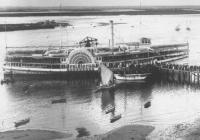 One hundred and twelve years ago today, the disaster on the General Slocum resulted in one of the largest loss of life in New York City prior to the attacks of 9/11/01.
One hundred and twelve years ago today, the disaster on the General Slocum resulted in one of the largest loss of life in New York City prior to the attacks of 9/11/01.
At around 9AM on June 15, 1904, approximately 1,350 passengers, mostly women and children from the German-American community of New York’s Lower East Side, boarded the Knickerbocker Steamship Company paddle steamer General Slocum for an annual end-of-school outing to Locust Grove Picnic Ground at Eatons Neck on Long Island. The trip was sponsored by the St. Mark’s Evangelical Lutheran Church.
Instead of a fun-filled day away from the city, the trip shortly turned into a nightmare. A fire broke out on the boat as she steamed up the East River at 15 knots. The fire spread quickly on the steamer which was built of white oak, locust, and yellow pine. Rather than attempt to bring the ship ashore in the narrow East River, Captain William Henry Van Schaick steered the burning ship to North Brother Island, where he ran the ship aground. The run to North Brother Island, however, only fanned the flames. Fire hoses used by the largely untrained crew turned out to be rotten. So too were lifejackets handed out to the panicking passengers. The steamer’s lifeboats were fixed in place and could not be lowered. Of the 1,350 passengers plus crew, 1,021 would die that afternoon, mostly women and children, from drowning or burns.
As noted by the New York Times: The New-York Historical Society currently houses more than 20 artifacts related to the event and its aftermath, including scrapbooks, the program for the outing, photographs and letters from survivors.
None are as quietly devastating as a pair of tiny black leather shoes worn by 3-year-old Anna C. Liebenow. Her family collected the shoes after her body was pulled from the East River several days after the fire; they were bequeathed to the Historical Society by Anna’s younger sister,Adella Liebenow Wotherspoon, who survived the event, upon her death in 2004.
The only remaining monuments to the General Slocum disaster are a little fountain at Tompkins Square Park and a slightly more prominent memorial (emblazoned with both an English and a German account of the event) at Lutheran-All Faiths Cemetery in Queens, where many of the unidentified Slocum victims were buried.
The General Slocum’s sinking was the single largest loss of life locally until Sept. 11, 2001. Mrs. Wotherspoon, who was the youngest passenger saved and became the disaster’s last survivor, was once asked, toward the end of her life, why this grim chapter in Manhattan history was mostly forgotten.
“The Titanic had a great many famous people on it,” she said. “This was just a family picnic.”

And the late Patrick Tull did a one man show about the disaster. I saw it in Edinburgh back when.
The run to North Brother Island Only fanned the flames!
This scenario of stepping on the gas pedal with a burning ship,
has been played out again, and again:
-Morro Castle
-Carnival Ecstasy
-….
-Burning ships are not like candles on a birthday cake,
you can’t blow them out